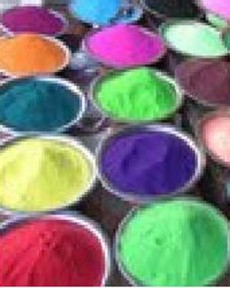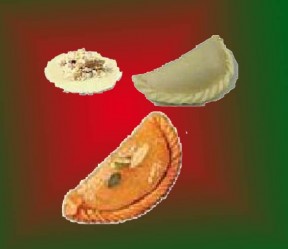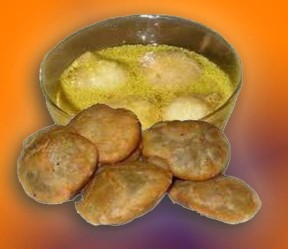 Kachoris … samosas … burfis … laddoos … traditional Indian delicacies that used to be the staple in every Indian home, even if they went by different names in different parts of the country. Today the exigencies of sedentary lifestyles make it inadvisable to indulge a passion for rich food on a regular basis.
Kachoris … samosas … burfis … laddoos … traditional Indian delicacies that used to be the staple in every Indian home, even if they went by different names in different parts of the country. Today the exigencies of sedentary lifestyles make it inadvisable to indulge a passion for rich food on a regular basis.
Festivals, however, are a God sent opportunity to pamper the taste buds, even though back-breaking work schedules usually mean that the festival goodies are bought in the market instead of being prepared at home, the way they used to be in our mothers’ and grandmothers’ time. Helping my own mother to prepare huge baskets full of kachoris and matthis, enormous jars full of homemade laddoos, almond and cashew burfis, homemade gulabjamuns … oh yes! It was a different life altogether! Now everything comes in brightly packaged boxes with plastic dividers, sealed with cellophane, and, for the most part, tasting like cardboard!
But this year it is a different story in my home. My ten-year-old daughter has started to show unmistakable signs of having inherited a passion for cooking, and I’m not surprised. She has it in her genes from both sides, after all. As the first pre-Holi matar kachoris arrived from the market two days ago, she bit into one and observed: “It’s nowhere near as good as the ones you used to make”.
I was zapped! She must have been about three when I had last made matar kachoris, in a more relaxed lifetime. “When did you eat matar kachoris that I made?” I asked her in amazement. “Don’t you remember mom?” she prodded, rolling her eyes. “It was when I was in playschool”.
OK—point taken. And then, she pressed home: “If you don’t have the time now, could you show me how to make it?” So, painted into the proverbial corner, I dredged up my recipe book—a legacy from my grandmother—and here we are. And something tells me we won’t be visiting too many halwais or sweetshops at festival time—at least till my daughter is old enough to have a hectic work schedule of her own!
Festivals in traditional communities the world over are usually associated with special food preparations. And Holi is associated as much with gujhiyas, matar kachoris and kanji-vada, as it is with colours, song and dance. So here are some simplified recipes for the traditional Holi fare:
Sweet Gujhiyas
For the stuffing:
Ingredients:
_ Mawa (khoya) – 400 gm
_ Semolina (suji) – 100 gm
_ Ghee – 2 tbsp
_ Powdered sugar – 400 gm
_ Cashew nuts – 100 gm (coarsely crushed)
_ Raisins – 50 gm (with stems removed)
_ Crushed seeds of 7-8 green cardamom (elaichi)
_ Desiccated/ powdered coconut – 100 gm
Procedure:
_ Dry roast the cashews and raisins lightly and keep aside.
_ Roast the semolina in ghee till light brown.
_ Mix the mawa, semolina, coconut powder, sugar and dry fruits well and keep aside.
For the Gujhiya shells
Ingredients:
_ White flour – 500 gm
_ Milk or Curd – 50 gm
_ Ghee – 125 gm
_ Oil for frying
Procedure:
_ Sieve the flour into a bowl. Pour melted ghee and mix thoroughly.
_ Add milk and knead into a tight dough with a little water. Cover with a wet cloth for half an hour.
_ Re-knead the dough after half an hour till it is smooth and pliable. Divide into round balls (around 50 to 55) and cover with a wet cloth.
_ Take the balls, one at a time and roll them out with a rolling pin into circles, about 4 inches in diameter. Arrange them in trays.
_ Now place a tablespoonful of the filling on each circle and fold them over into crescents. The edges can either be pressed together with a wet finger and thumb, or folded into spirals (see picture), or else sealed by placing the gujhiyas in a mould with crimped edges.
_ Heat oil in a kadahi and fry the gujhiyas on a medium flame, to a golden colour, about 7 to 8 at a time. Can be consumed hot, or cooled at room temperature and stored for upto 15 days.
Additional tip:
The gujhiyas can be dipped in a syrup of equal part of sugar and water for extra sweetness and a glazed look, and garnished with slivers of pistachios and almonds (see picture).
Matar Kachoris
For the stuffing:
Ingredients:
_ Shelled peas – 250 gm
_ Ghee – 2 tbsp
_ Salt to taste
_ Red chilli powder – 2 tsp
_ Dhania (coriander) powder – 2 tbsp
_ Amchoor (dried mango) powder – 1 tbsp
_ Saunth (dried ginger) powder – 1 tsp
Procedure:
_ Heat the ghee in a pan. Add the shelled peas and 2 tbsp water.
_ Cover tightly and cook till the peas are tender.
_ Add all the spices, mix well, and set aside to cool. Make the stuffing a little saltier and spicier than your normal taste since the shells contain no salt or spices.
For the Kachoris
Ingredients:
_ Refined flour – 500 gm
_ Ghee – 125 gm
_ Oil for frying
Procedure:
_ Sieve the flour into a bowl. Pour melted ghee and mix thoroughly.
_ Knead into a tight dough with a little warm water. Cover with a wet cloth for half an hour.
_ Re-knead the dough after half an hour till it is smooth and pliable. Divide into round balls (around 25 to 30) and cover with a wet cloth.
_ Take the balls, one at a time in the palm of the hand. Spread it out a little with your fingers and place a heaped tsp of the pea stuffing in the centre.
_ Gather the edges of the dough and pinch them shut firmly with your fingers.
_ Flatten the ball between your palms and place in a tray.
_ Fill and seal all the kachoris in the same way and keep aside.
_ Heat oil in a kadahi and fry the kachoris on a medium flame, to a golden colour, about 8 to 10 at a time. Can be consumed hot, or cooled at room temperature and stored for upto a week in pleasant weather.
Additional tip:
The kachoris can be served with a savoury potato gravy—a favourite combo in north India.
Kanji Vadas
For the vadas:
Ingredients:
_ Yellow moong dal (lentils) – 1 cup, soaked for 1 hour
_ Oil for frying
Procedure:
_ Drain the soaked dal well and grind, a little coarsely (either on stone, or in a grinder), into a thick pitthi (stiff batter).
_ Beat till it is light, fluffy and almost white in colour (it is much easier to use an electric whisk).
_ Heat oil in a kadahi. Drop balls of the fluffy batter into the oil (8 to 10 at a time) and fry on a medium flame, till golden. Remove from the kadahi onto a sheet of blotting paper. Set aside to cool.
For the Kanji
Ingredients:
_ Water – 5 litres
_ Salt – 3 heaped tablespoons
_ Powdered rye – 2 heaped tablespoons
_ Red chilli powder – 1 heaped tablespoon
Procedure:
_ Mix the salt, powdered rye and red chilli powder in the water.
_ Cover with a cloth and keep it in sunlight for 4 to 5 days.
_ After the kanji has matured sufficiently (turned sour and spicy), store in a jar and add the vadas.
_ Serve in bowls or glasses. Maintains taste upto 3 or 4 days.
Additional tips:
_ If pressed for time, can use lukewarm water. The kanji will be ready in 48 hours.
_ Can be topped with green mint and coriander chutney while serving.








‘tasting like cardboard’… LOL…I love matar kachoris and I am sure as hell gonna try this one. And your daughter’s growing up to be a fine young lady, Parul…HAPPY HOLI…
Thanks and same to you Vaishali … love to cook whenever I can
In Gujarat we make something called “ghughras” which are very similar…I’d say perfect snack for holi where colours from all states merge into one!
Festivals in India are Fabulous, food glorious food!!
looking for more recipes . I am a bad cook but love to collect recipes BUT i am going to try these.